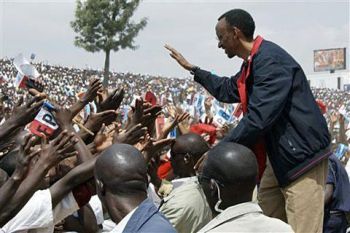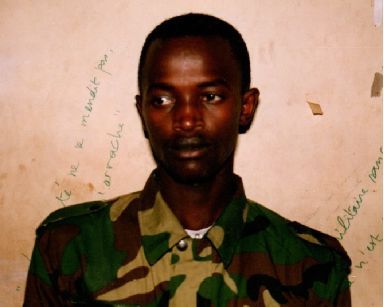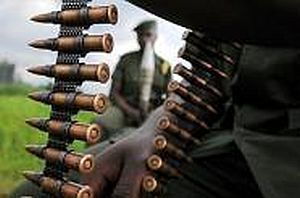
Publisher:
Bonnie King
CONTACT:
Newsroom@Salem-news.com
Advertising:
Adsales@Salem-news.com

~Truth~
~Justice~
~Peace~
TJP
Apr-02-2012 16:56

 TweetFollow @OregonNews
TweetFollow @OregonNews
Behind The Presidential Curtains: A Hungry President the Truth Behind Congo War
Noble Marara for Salem-News.comFormer bodyguard for Paul Kagame reveals more background on Rwandan President.
 Paul Kagame, President of Rwanda |
(KIGALI, Rwanda) - After the overthrow of Mobutu of Zaire and naming it Democratic Republic of Congo, Paul Kagame was convinced that his Government will have the biggest access of Congo’s wealth and the right to do whatever he wished without any hindrance.
 Soldiers in The Congo |
Kagame made Desire Kabila the new president of the DRC, convincing himself that he would use him to control and grab all he laid his hands on in the Congo. At that time Kagame has deployed the DRC with most of his senior trusted officers to control not only the wealthy country but also President Kabila. Kagame’s own right hand man Gen James Kabarebe headed the Congolese army.
President Desire Kabila got a bit skeptical of Kagame’s long time goals and sought advice from his senior officers (Congolese).
This came following an incident where Kagame had confiscated arms, ammunitions and vehicles Kabila’s government had purchased through the Rwanda army. These logistics included artillery pieces such Ballistic Missiles (BM), Heavy and Light Anti-Aircraft pieces, General Purpose Machine Guns (GPMG), 48 Nissan Patrol 4×4 Trucks and 80 Land Rovers Jeeps. Kagame decided to only dispatch a half of these logistics to Congo keeping the rest for himself. This caused a lot of anger, distrust and chaos to Kabila and his government. In return Kabila ordered the Rwandan forces under their most senior Commander General James Kabarebe to leave the country.
He was made to leave the country without taking even the car he was travelling in to the airport, something that annoyed the whole army.
 A former RPF soldier, Noble Marara was an eyewitness to |
On their arrival at Kanombe International Airport, we drove his excellence Paul Kagame to meet with them. This force was immediately ordered to go to Camp GP (Presidential Guard Barracks) and wait for more orders as they remain on standby. He seemed physically angered and disappointed at that time.
After twenty four hours we went to Camp GP with Paul Kagame to brief the forces why they should immediately go back to the Congo to fight Kabila, the man they had just installed in power.
Surprisingly everyone supported the idea because at that time all soldiers seemed to believe that they would keep their loot on return from the DRC. These included gems and American Dollars the currency Congo used. Desire Kabila on the other hand had solicited for troops from Zimbabwe and Angola to take over deployments after the departure of the Rwandese forces.
When Kagame’s forces attacked Congo this second time, they could not believe how massively Kabila had deployed. Our forces sustained big losses and casualties this time around. The first Congo war was a bit easier because Kagame negotiated with President Chiluba of Zambia to offer our troops the quickest route to Kinshasa. When Kagame attempted to ask for the second attack route to oust Kabila on this second time, President Chiluba declined, reminding Kagame that: ‘’I thought Mobutu was a bad man and a dictator what about Kabila you came with to visit me, why fight him now’’.
This Second Congo War (also known as the Great War of Africa) began in August 1998 in the DRC, and officially ended in July 2003 when the transitional government took power.
The deadliest war in modern African history, it directly involved eight African nations, as well as about 25 armed groups. Surprisingly President Paul Kagame created more than 8 armed groups to destabilise the region for his own interests. By 2008, the war had claimed lives of over 5.4 million people, mostly from diseases and starvation, making the Second Congo War the deadliest conflict worldwide since the world war. Millions more were displaced from their homes or sought refuge in neighbouring countries. This was all caused by Kagame’s idea of wanting to make himself the richest man on the globe.
Despite a formal end to the war in July 2003 and an agreement by the former belligerents to create a government of national unity, 1,000 people died daily in 2004 from easily preventable cases of malnutrition and disease. The war and the conflicts afterwards were driven by, among other things, the trade in minerals.
The first Congo war began in 1996 as Rwanda grew increasingly concerned about members of Interahamwe militias and former Rwanda Government Forces who were carrying out cross-border raids from Zaire (currently known as the Democratic Republic of Congo) and thought to be planning an invasion.
The militias, mostly Hutu, were entrenched in refugee camps in eastern Zaire, where many had fled to escape the Tutsi-dominated RPF in the aftermath of the Rwanda Genocide.
Kagame’s government of Rwanda protested this violation of their territorial integrity and began to give arms to the ethnically Tutsi Banyamulenge of eastern Zaire. It was evident that the insurgents were so weak to attack a country like Rwanda; they had fled to the forests of Congo to try and find a living for their families. Most of them however had joined Kagame’s forces but he kept on lying to the world that he was fighting the Hutu militia when they had actually joined his own army after what he calls voluntary repatriation.
When Kabila finally gained control over the capital in May 1997, he faced substantial obstacles to governing the country, which he renamed ‘the Democratic Republic of Congo’ (DRC). Beyond political jostling among various groups to gain power and an enormous external debt, his foreign backers proved unwilling to leave when asked. The conspicuous Rwandan presence in the capital also ranked many Congolese, who were beginning to see Kabila as a pawn of foreign powers.
 |
Tensions reached new heights on 14 July 1998, when Kabila dismissed his Rwandan chief of staff James Kabarebe and replaced him with a native Congolese, Celestin Kifwa. Although the move chilled what was already a troubled relationship with Rwanda, he softened the blow by making Kabarebe the military advisor to his successor. Two weeks later, Kabila abandoned such diplomatic steps. He thanked Rwanda for its help and ordered all Rwandan and Ugandan military forces to leave the country. Within 24 hours Rwandan military advisors living in Kinshasa were unceremoniously flown out. The people most alarmed by this order were the Banyamulenge of eastern Congo. Their tensions with neighbouring ethnic groups had been a contributing factor in the genesis of the first Congo war and they were also used by Rwanda to affect events across the border in the DRC.
This was all triggered by Kagame’s long arm of theft of Minerals, Ammunitions, Money and Vehicles. Not only civilians and younger soldiers died but also the commanders such as General Masasu, Colonel Wilson Rutaisire, Major Ikondere and in the end Desire Kabila himself and others. According to his excellence Paul Kagame our aim was to fight the hutu militias who were threatening to come back and kill the innocent civilians, however we crossed the border and headed to Kinshasha, but the so called militias were hiding in the forests of Katanga region and equatorial. After the international community pressure the Rwandese soldiers withdrew and we haven’t seen any militias attack Rwanda, so what else do we need to question the cause of the war that swiped a millions of lives?
By: Noble Marara, former Presidential Guard to Paul Kagame, Rwanda
Edited and submitted by: Jennifer Fierberg, MSW; a correspondent, Assistant Editor, and Volunteer Coordinator for NGO News Africa through the volunteer project of the UN. Jennifer is also the media co-coordinator and senior funding executive for The Africa Global Village (www.africaglobalvillage.com)
 |
 |
 |
 |
 |
 |
Articles for April 1, 2012 | Articles for April 2, 2012 | Articles for April 3, 2012

Quick Links
DINING
Willamette UniversityGoudy Commons Cafe
Dine on the Queen
Willamette Queen Sternwheeler
MUST SEE SALEM
Oregon Capitol ToursCapitol History Gateway
Willamette River Ride
Willamette Queen Sternwheeler
Historic Home Tours:
Deepwood Museum
The Bush House
Gaiety Hollow Garden
AUCTIONS - APPRAISALS
Auction Masters & AppraisalsCONSTRUCTION SERVICES
Roofing and ContractingSheridan, Ore.
ONLINE SHOPPING
Special Occasion DressesAdvertise with Salem-News
Contact:AdSales@Salem-News.com
Salem-News.com:


Terms of Service | Privacy Policy
All comments and messages are approved by people and self promotional links or unacceptable comments are denied.
Mwana Mboka April 3, 2012 1:06 pm (Pacific time)
This is a great job except one thing. There is no Banyamulenge tribe in the Eastern Congo. Those are Tutsi Rwandese who moved into Congo to create confusion. They represents the key of this war. They need to go back home in Rwanda. I am Congolese, I grew up in the Eastern Congo. I know what all this is about. God Bless Congo.
Ursoel MAYUMBU April 3, 2012 9:00 am (Pacific time)
President Paul Kagame of Rwanda is a criminal and Joseph kabila is a criminal too, they both kill people if the Democratic Republic of Congo, nobody can let them enjoy killing people we need to stand up and stop them
TM April 3, 2012 5:44 am (Pacific time)
This must be a fabricated story. Kagame has never used a Hutu escort at that period. Marara looks a Hutu, this is a story made to gain asylum.
[Return to Top]©2025 Salem-News.com. All opinions expressed in this article are those of the author and do not necessarily reflect those of Salem-News.com.